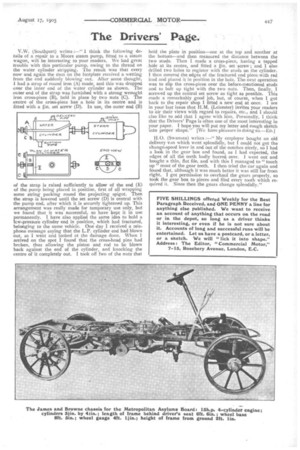The Drivers' Page.
Page 13

If you've noticed an error in this article please click here to report it so we can fix it.
V.W. (Southport) writes :—" I think the following details of a repair to a Moore steam pump, fitted to a steam wagon, will be interesting to your readers. We had great trouble with this particular pump, owing to the thread on the water cylinder stripping. The result was that every now and again the men on the footplate received a wetting from the end suddenly blowing out. After some thought, I had a strap of round iron (A) made, and this was dropped over the inner end of the water cylinder as shown. The outer end of the strap was furnished with a strong wrought iron cross-piece (B), held in place by two nuts (C). The centre of the cross-piece has a hole in its centre and is fitted with a fin. set screw (D). In use, the outer end (B)
of the strap is raised sufficiently to allow of the end (E) of the pump being placed in position, first of all wrapping some string packing round the projecting spigot. Then the strap is lowered until the set screw (D) is central with the pump end, after which it is securely tightened up. This arrangement was really made for temporary use only, but we found that it was successful, so have kept it in use permanently. I have also applied the same idea to hold a low-pressure cylinder end in position, which had fractured, belonging to the same vehicle. One day I received a telephone message saying that the L.P. cylinder end had blown out, so I went and looked at the damage done. When arrived on the spot I found that the cross-head pins had broken, thus allowing the piston and rod to be blown back against the end of the cylinder, and knocking the centre of it completely out. I took off fwo of the nuts that held the plate in position—one at the top and another at the bottom—and then measured the distance between the two studs_ Then I made a cross-piece, having a tapped hole at its centre, and fitted a fin. set screw ; and I also drilled two holes to register with the studs on the cylinder. I then covered the edges of the fractured end piece with red lead and placed it in position in the hole_ The next operation was to slip the cross-piece over the before-mentioned studs and to bolt up tight with the two nuts. Then, finally, I screwed up the central set screw as tight as possible. This made a remarkably good job, but, of course, when I got back to the repair shop I fitted a new end at once. I see in your last issue that H.M. (Leicester) invites your readers to air their views with regard to repairs, etc., and I should also like to add that I agree with him. Personally, I think that the Drivers' Page is often one of the most interesting in your paper. I hope you will put my letter and rough sketch into proper shape." [We have pleasure in doing 50.—ED.]
H.O. (Swansea) writes My employer bought an old
delivery van which went splendidly, but I could not get the change-speed lever in and out of the notches nicely, so I had a look in the gear box and found, as I had expected, the edges of all the teeth badly burred over. I went out and bought a thin, flat file, and with this I managed to "touch up" most of the gear teeth. I then tried the car again and found that, although it was much better it was still far from right. I got permission to overhaul the gears properly, so took the gear box to pieces and filed every tooth which required it. Since then the gears change splendidly."
















